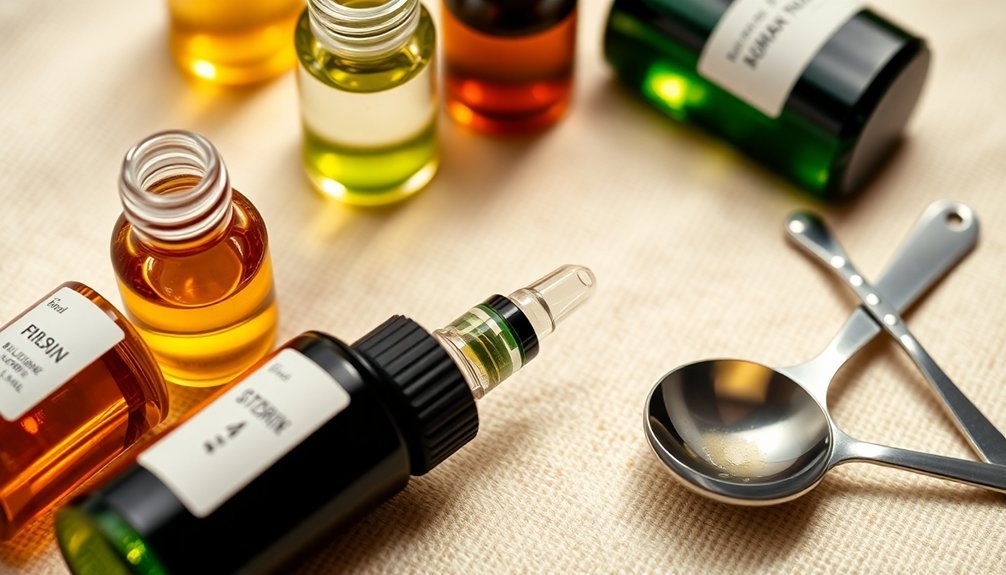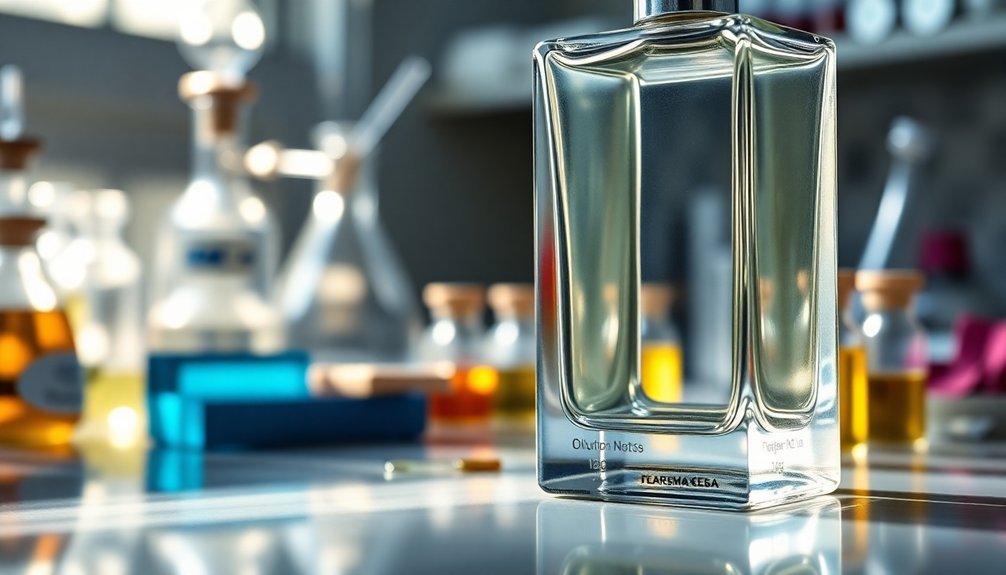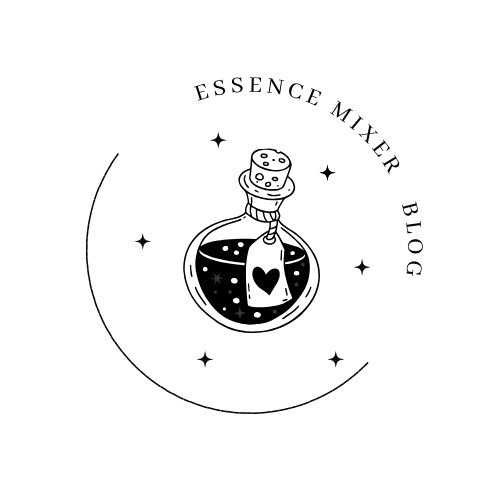For safe perfume oil blends, you'll want to stick to a 10-20% dilution rate when using synthetic fragrance oils, but only 1-3% for natural essential oils in your formula. Always use a carrier oil as your base and measure ingredients precisely with a digital scale rather than counting drops. Before applying broadly, do a 24-hour patch test on your skin to check for reactions. Understanding proper dilution ratios will help you create beautiful, skin-safe fragrances.
Understanding Basic Perfume Oil Dilution Ratios

When creating perfume oil blends, proper dilution is essential for both safety and effectiveness.
You'll need to mix your essential oils with a carrier oil at the right concentration to protect your skin while maintaining the desired fragrance strength. For most perfume blends, you can use a 10-20% dilution rate of essential oils in your carrier oil.
If you have sensitive skin, it's best to stay around 15% concentration. This differs from other body care products, which require much lower dilutions – just 1-3% for items like lotions or bath products. Before using any essential oil blend, performing a 24-hour patch test will help ensure you don't have any adverse reactions.
Remember that proper measurement is vital, so you'll want to use the right tools. For example, in a 5ml rollerball bottle, you'd use about 20 drops of essential oils with 80 drops of carrier oil for a 20% dilution.
Essential Safety Guidelines for Fragrance Blending
Before creating your fragrance blends, you'll need to follow essential safety dilution rules starting with a maximum 5% concentration for perfumes.
You must test each blend on a small patch of skin to check for adverse reactions before full application.
Always remember that undiluted essential oils can cause skin irritation or burns, making proper dilution your first line of defense in safe perfume creation.
Using vegetable-based carrier oils helps ensure even distribution and proper absorption of your essential oil blend.
Basic Safety Dilution Rules
Since fragrance oil blending requires careful attention to safety, following proper dilution guidelines is crucial to prevent skin irritation and adverse reactions. You'll need to maintain a dilution rate between 0.5% to 2% for most body care products, though perfumes can go up to 5% since they're applied sparingly. For accurate measurements, use 3-12 drops of essential oil per ounce of finished product. For professional perfumery, using a precise scale in grams ensures the most accurate measurements for safe dilutions.
| Product Type | Safe Dilution Rate | Drops per Ounce |
|---|---|---|
| Body Care | 0.5-2% | 3-12 drops |
| Perfumes | Up to 5% | 15-30 drops |
| Spot Testing | 0.5% | 3 drops |
Always wear protective gear like gloves and goggles when handling concentrated oils, and guarantee proper ventilation in your workspace. If irritation occurs, immediately wash the affected area and seek medical attention if symptoms persist.
Testing Before Full Application
Proper testing protocols build upon basic safety dilution rules to guarantee your fragrance blends are both safe and appealing. Start by placing 1-2 drops of your diluted blend on a fragrance testing strip, then evaluate the scent at specific intervals – immediately after application, at 1 minute, 5 minutes, 10 minutes, 30 minutes, and beyond.
To maintain accuracy in your evaluations, take breaks between testing different blends and use coffee beans to refresh your nasal receptors.
You'll want to let your blend mature for several days, as the scent profile can change considerably during this time. Document everything in your perfume formula cards – including measurements, notes, and observations at different stages.
This systematic approach helps you refine your formulas while ensuring safety and consistency.
Selecting the Right Carrier Oils for Your Blend

When crafting your perfect perfume blend, choosing the right carrier oil serves as the foundation for your fragrance's success.
You'll want to match your carrier oil to your skin type while considering how it affects your perfume's scent and longevity.
For oily skin, opt for lightweight options like grapeseed or fractionated coconut oil, which absorb quickly without leaving a greasy residue.
If you have dry skin, you'll benefit from argan oil's rich moisturizing properties.
Jojoba oil works universally for all skin types and won't interfere with your fragrance's aroma, thanks to its odorless nature.
Consider how your carrier oil's natural scent might interact with your perfume.
While jojoba and fractionated coconut oil are neutral, sweet almond and argan oils add subtle nutty notes to your blend.
Proper Measurement Methods for Safe Dilution
You'll need a precise digital scale that measures to 0.01g rather than relying on unreliable drop measurements when creating your perfume oil blends.
For accurate dilutions, use clean glass beakers or droppers to transfer your ingredients, and consider investing in amber or cobalt blue bottles to protect your final mixture from light degradation.
Your measurements should always be calculated as percentages of the total volume, which helps maintain consistency and safety in your formulations.
Measuring Tools and Equipment
Accurate measurement stands at the heart of successful perfume oil blending. You'll need specific tools to guarantee precise dilutions and maintain safety standards. A well-equipped workstation includes glass pipettes, HDPE containers, and digital scales for ideal accuracy.
| Tool | Purpose | Important Features |
|---|---|---|
| Glass Pipettes | Drop measurement | Precise control, easy cleaning |
| Digital Scale | Weight measurement | Accuracy to 0.01g |
| HDPE Bottles | Safe storage | Chemical resistant |
| Reducer Inserts | Drop control | Consistent dispensing |
| Measuring Spoons | Larger quantities | Standard measurements |
For day-to-day blending, you'll want to use bottle reducers or glass pipettes for drops, while digital scales work best for larger quantities. Keep your tools clean and dry to prevent contamination. Don't forget to maintain a spreadsheet of your formulations, allowing you to scale recipes up or down while preserving proper ratios.
Converting Drops to Milliliters
Understanding drop-to-milliliter conversion forms the foundation of precise perfume blending.
While the industry standard suggests that 20 drops equal 1 mL, you'll find this isn't always accurate. Drop sizes can vary considerably, ranging from 18 to 41 drops per mL, depending on your dropper type and the oil's viscosity.
To guarantee consistency in your measurements, it's essential to use the same dropper and oil type throughout your blending process.
For the most accurate results, you'll want to invest in graduated pipettes or cylinders, especially when scaling recipes. These tools provide more reliable measurements than counting drops.
If you're creating professional blends or larger batches, consider using a precision scale that measures to 0.01g instead of relying on drop counts.
Digital Scale Best Practices
Digital scales have become the gold standard for professional perfume blending, surpassing traditional drop-counting methods. You'll need a scale that measures to 0.01g for precise measurements, guaranteeing your dilutions are safe and consistent.
Always place your scale on a flat, stable surface and calibrate it before each use. Make sure to tare (zero) the scale with your container before adding ingredients.
You'll want to convert all measurements to grams rather than using volume measurements or drops, as this provides better accuracy and reproducibility.
Keep a spreadsheet to track your calculations and guarantee your total formula adds up to 100%.
Don't forget to check IFRA guidelines for safety limits on your materials, and document all measurements for future reference and regulatory compliance.
Common Dilution Mistakes to Avoid
Making safe and effective fragrance blends requires careful attention to dilution practices, yet many perfumers fall into common traps that can compromise their creations. You'll need to avoid using drops instead of precise measurements, as this leads to inconsistent results.
| Common Mistake | Impact | Solution |
|---|---|---|
| Over-concentration | Skin irritation | Stick to 1-3% for essential oils |
| Wrong carrier choice | Poor evaporation | Use proper perfumer's alcohol |
| Improper measurement | Inconsistent results | Invest in digital scale |
Don't exceed the recommended 2% essential oil content in body care formulations, and always adjust your dilution rates based on your specific application. Remember that synthetic fragrance oils can handle higher dilutions (10-20%) than essential oils, but you'll still need to perform patch tests before broad application to guarantee safety.
Testing and Adjusting Your Perfume Formula

Quality testing forms the backbone of successful perfume development. You'll need to test your formula under controlled conditions that simulate real-world use. Verify your test samples accurately represent your final product, whether they're from your own formulations or market benchmarks.
When testing your perfume formula, focus on these critical aspects:
- Environment control – Maintain temperature between 5°C-40°C and humidity between 30%-65% in an appropriate testing space.
- Scent evaluation – Have at least thirty testers rate your fragrance's strength and appeal on a 1-10 scale.
- Stability assessment – Monitor how your formula performs over time, checking for any degradation or structural changes.
If your test results don't meet standards, make adjustments based on tester feedback and quantitative data.
Continue testing and refining until you achieve your desired performance metrics.
Frequently Asked Questions
Can I Use Water Instead of Alcohol to Dilute Perfume Oils?
No, you can't use water to dilute perfume oils since they won't mix properly. You'll need alcohol or carrier oils instead, as water doesn't dissolve oils and won't help stabilize your fragrance blend.
How Long Can I Store My Diluted Perfume Oil Blend?
You can store your diluted perfume oil blend for up to 2 years if you've stored it properly in dark glass bottles, away from light and heat. Keep bottles tightly sealed to maintain quality.
Do Different Skin Types Require Different Dilution Rates?
Yes, you'll need different dilution rates: use 0.2-1% for sensitive skin, 1-2% for normal skin, and 2-3% for therapeutic purposes. Always patch test and adjust concentrations based on your skin's response.
What's the Best Temperature for Blending and Storing Perfume Oils?
You'll want to store your perfume oils between 60-70°F (15-21°C) in a cool, dry place. Keep them away from direct sunlight and heat sources to prevent degradation of your fragrance blends.
Can I Layer Multiple Perfume Oil Blends Without Exceeding Safety Limits?
You shouldn't layer more than two perfume oil blends to avoid exceeding safe fragrance limits. If you have sensitive skin, stick to one blend and always do a patch test before applying.
In Summary
When you're creating perfume oil blends, stick to a safe dilution rate of 15-30% fragrance oils to 70-85% carrier oils. Test your mixture on a small patch of skin and adjust if needed. Remember you'll get better results using proper measuring tools rather than eyeballing amounts. Start with lower concentrations and work your way up until you achieve your desired scent strength while maintaining safety.





Leave a Reply